Diving into the vast world of aquatic life, it’s fascinating to discover the myriad of fish species that inhabit our oceans, rivers, and lakes. While some names might be familiar, others can pique our curiosity simply by the initial letter they start with. For example, have you ever wondered about fish names that begin with the letter W?
From the well-known to the wonderfully obscure, we’ve compiled a complete list to satisfy your curiosity. So, let’s dive in!
1. Wahoo (Acanthocybium solandri)
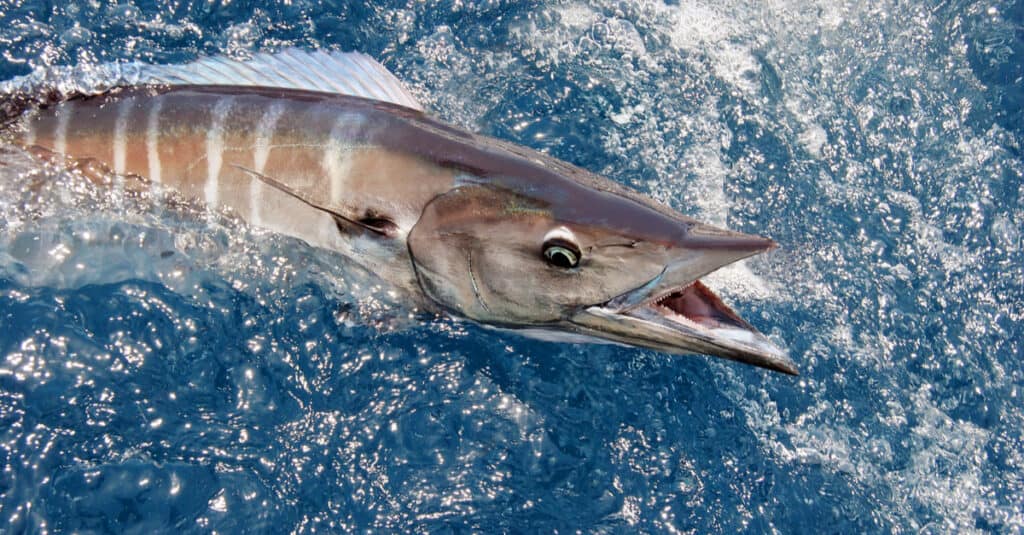
One fish that starts with W is the wahoo.
©Neophuket/Shutterstock.com
Wahoo thrive in the warm regions of oceans across the world. This sleek marine creature sports a body blanketed in scales, and its jaws stretch out, resembling a subtle beak. With triangular, razor-sharp teeth, they’re perfectly equipped for the hunt. Notably, it has two dorsal fins – the front one being notably longer than the rear, complemented by 8 or 9 smaller finlets trailing behind.
While they can shoot up to a whopping 8 feet in length, you’ll usually spot them measuring anywhere from 3.3 to 5.4 feet. Though they’re often seen around reefs, these fish are not strangers to the vastness of the open ocean.
Their menu primarily consists of squid and fish like butterfish and round herring.
2. Walking Catfish (Clarias batrachus)
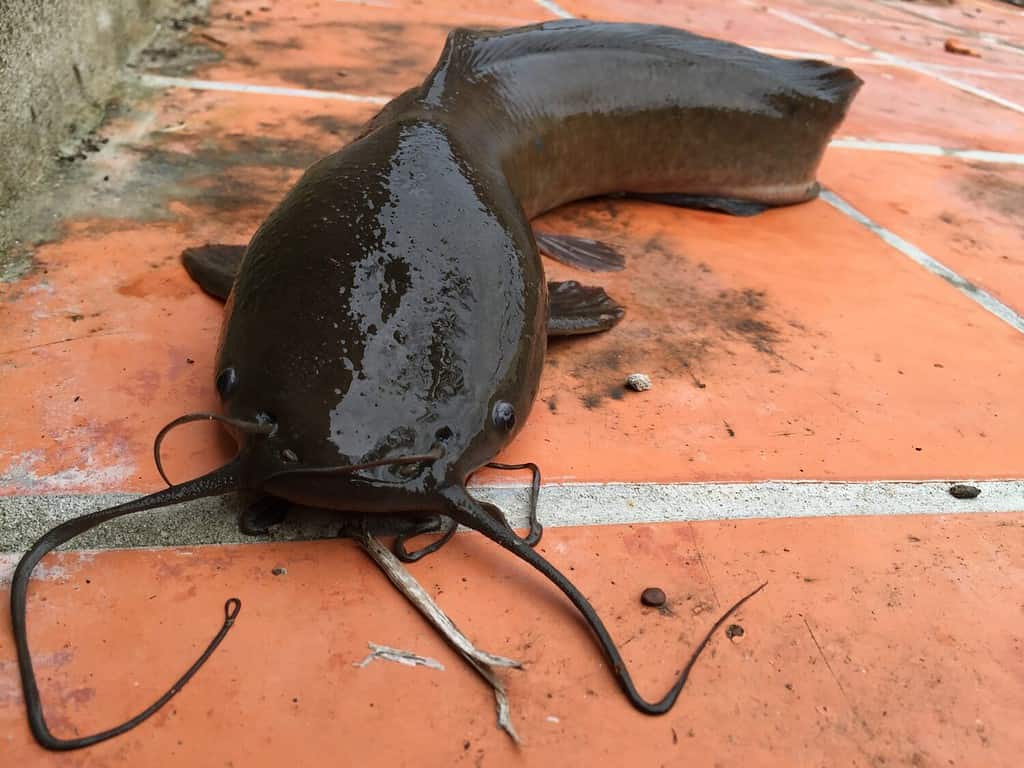
Yes, the
walking catfish
can indeed “walk.
©Trieu Tuan/Shutterstock.com
The walking catfish, native to Southeast Asia, is a unique freshwater fish that has an intriguing ability to “walk” on dry ground by wriggling its body, helping it seek out food or a better habitat.
Characterized by a uniform shade of either gray or a dusky brown, the fish is dotted with tiny white specks on its sides. Its head is wide and flat, leading to a slender body that narrows towards the tail, reminiscent of a svelte tadpole. Although its mouth appears large, it doesn’t open very wide.
When it comes to growth, these catfish grow rather quickly, usually reaching lengths of around 12 inches. However, some can grow as long as 20 inches. They’re commonly found in warm, still waters with low oxygen levels, such as muddy ponds, ditches, and marshy areas.
These catfish are versatile eaters, feeding on anything from small fish and water bugs to plants and even deceased aquatic creatures.
3. Walleye (Sander vitreus)
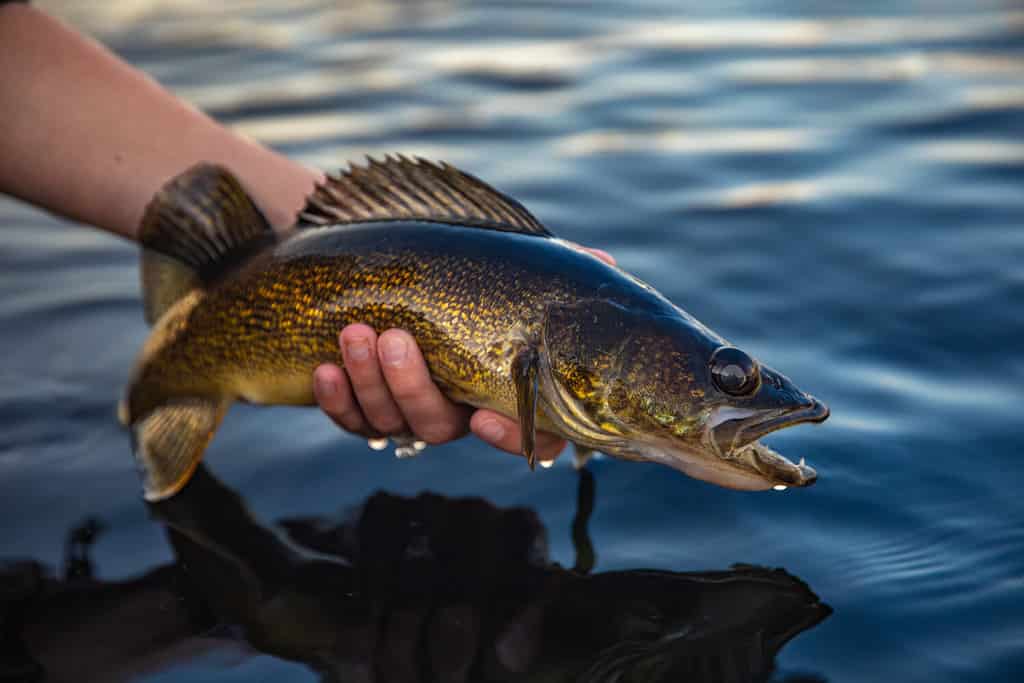
Measuring up to 3 feet long, walleye is a popular freshwater fish.
©Harlan Schwartz/Shutterstock.com
Walleye originate from Canada, the regions around the Great Lakes, the upper Mississippi Rivers, and the basins of Missouri. Additionally, they’ve been introduced to areas in the western and northeastern U.S.
Resembling perch in appearance, walleye have a distinctive dorsal fin on their backs, which is split into two sections. The front section has sharp spines, while the back portion is smooth. They sport a deep green hue on their backs, transitioning to bright golden yellow on their sides, ending with a pale belly.
Typically measuring between 2.5 to 3 feet, walleye gravitate towards the calm, deep, and cool waters found in rivers, lakes, and reservoirs.
Primarily hunting at night, walleye prey on unsuspecting fish that might be resting. Their diet often includes freshwater drums, bullheads, yellow perch, and minnows.
4. Warmouth (Lepomis gulosus)
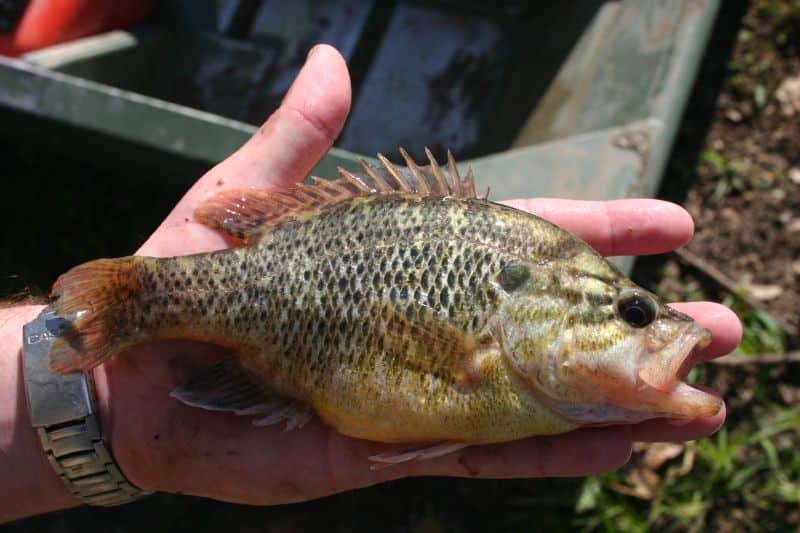
Found in the US and Mexico, the warmouth generally eats insects, small crustaceans, and other fish.
©Clinton & Charles Robertson from RAF Lakenheath, UK & San Marcos, TX, USA & UK / CC BY-SA 2.0 – License
Warmouth fish hail from the eastern regions of the United States but are now widespread across the U.S. and Mexico.
The adult fish have a dark, uneven brown hue. They have a golden underbelly, and males are easily identifiable by the vibrant orange marking near the beginning of their dorsal fin. Distinctive reddish-brown lines can be seen extending from their eyes, and their gill covers often have a reddish tint.
Typically, they measure anywhere from 4 to 10 inches in length. They thrive in environments like lakes, ponds, swamps, and calm parts of streams that have muddy bases and are lined with plants.
When it comes to food, warmouth mainly feast on insects, small crustaceans like crayfish, and other fish.
5. Weather Loach (Misgurnus anguillicaudatus)

One of the most popular aquarium fish that start with W is the weather loach.
©Tomasz Klejdysz/iStock via Getty Images
The weather loach is native to East Asia. Its presence in North America can be attributed to various reasons, including its popularity in aquariums, its role in the food market, its use as bait, accidental mishaps, and deliberate introductions.
These fish exhibit diverse color patterns. Some have a shiny, almost metallic hue, while others are muted brown. Certain ones flaunt striking designs, whereas some might only have faint speckles. There’s also a unique “golden” version with reduced color, featuring dark eyes, and on rare occasions, you might spot a true albino.
Usually, they grow up to 10 inches. Their natural habitats are places like shallow rivers, rice fields, and even roadside ditches.
They primarily feed on insect larvae, tiny shellfish, and waste in their natural settings. But they also have an appetite for fresh veggies.
6. West African Bichir (Polypterus retropinnis)
Originating from tropical West Africa, the West African bichir is a unique freshwater fish.
This fish, with its slender, tube-like body, can grow up to 13 inches long. One distinctive feature setting it apart from its kin is its equally-sized jaws. And if you get a chance to see one up close, its creamy eyes speckled with black dots are quite a sight.
Its preferred hangouts are the marshy swamps and water-filled plains. By day, this fish tends to stay hidden, but at nighttime, it’s out hunting worms, water bugs, and tiny fish.
7. Western Mosquitofish (Gambusia affinis)
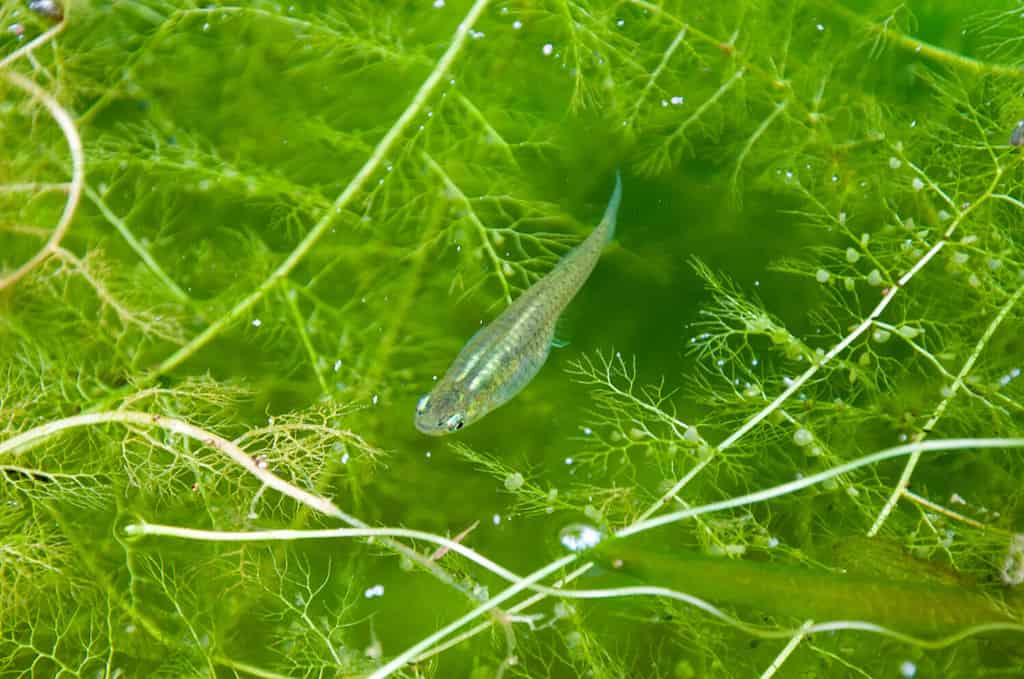
The western mosquitofish can grow up to 2.5 inches.
©Lorenzo Sala/Shutterstock.com
Hailing from North America’s freshwater regions, the western mosquitofish is a little creature. Distinct vertical stripes over its eyes give it a masked look. Recognizable traits include a gray hue, an upward-facing mouth, and a rounded tail fin. Also, a dark lining adorns each of its scales. While female mosquitofish can grow up to 2.5 inches, their male counterparts usually stay under 1.5 inches.
These fish love warm, shallow waters rich in vegetation, often seen skimming the surface in pockets of water just inches deep, either alone or in small clusters.
Being omnivorous, they have a remarkable fondness for mosquitoes, hence their name. Impressively, a mature female can gobble down hundreds of mosquito larvae daily.
8. Waterfall Climbing Cave Fish (Cryptotora thamicola)
Originating from Thailand, the waterfall climbing cave fish is a unique species found in secluded hill streams. Growing up to a modest 1.1 inches, this fish stands out because of its peculiar fins. These fins enable it to latch onto surfaces and, incredibly, even climb. Whether it’s scaling rocks in swift waters or moving across moist areas out of the water, this fish is up for the task.
It’s spotted primarily in eight hidden spots within the vast Pang Mapha cave formations in Thailand’s Mae Hong Son Province.
Among all cave-dwelling fish, this one’s perhaps the most specialized for cave life. Its distinct features include a lack of color and an absence of eyes. As for its diet, it consumes bacterial layers that form on rock surfaces near waterfalls or swift currents.
9. Wolf Herring (Chirocentrus dorab)

Averaging around 5 feet long, wolf herrings can be dangerous to smaller fish.
©Valerii Evlakhov/iStock via Getty Images
The wolf herring is a marine fish that calls the waters of the Indian Ocean, western Pacific, Japan, and eastern Australia home. This fish boasts a slender, streamlined body with a unique sharp underside. Tiny, smooth scales cover its body. Notably, its dorsal and anal fins are situated towards the tail end. Its mouth, which points upwards, is equipped with prominent canine teeth in both the upper and lower jaws. Given its considerable size, averaging around 5 feet, it poses a risk to many smaller fish species due to its predatory nature.
Primarily, wolf herring has a diet that consists of fish, especially types like clupeids and engraulids. However, they don’t shy away from crustaceans, squids, and other smaller marine creatures either.
10. White Seabass (Atractoscion nobilis)

The white seabass isn’t a picky eater.
©Tomascastelazo / CC BY-SA 3.0 – License
In California, the white seabass is the largest fish within the croaker family (Sciaenidae). Their habitat stretches from Magdalena Bay in Baja, California, Mexico, all the way to Juneau, Alaska.
Sporting a somewhat elongated body, the white seabass showcases a blue-gray hue on its upper side, while the underbelly gleams silver. A distinguishing feature is its broad mouth with the lower jaw slightly jutting out, paired with two dorsal fins.
Typically, this adaptable fish measures around 3 feet, though some exceptional ones in California have reached up to 5 feet. Preferring both saltwater and slightly saline environments, they adapt well to varying water conditions.
In terms of diet, white seabass aren’t picky; they feed on a mix of free-swimming fish and various small marine creatures.
The Largest Fish That Starts With W

Unsurprisingly, the largest fish that starts with W is the largest fish in the world: the whale shark!
©Jan Finsterbusch/Shutterstock.com
The title of the biggest fish starting with the letter W goes to the “whale shark”! In fact, it’s the largest fish species in existence today. One of the best places to spot these gentle giants is Australia.
Contrary to their name, they aren’t whales; they’re sharks, and they pose no threat to humans. A distinguishing feature is their vast mouth located right at the front of their head, unlike many sharks, which have mouths underneath. These creatures boast flat, expansive heads, rounded snouts, tiny eyes, and have 5 prominent gill slits. They also sport two dorsal fins and a pair of pectoral fins.
In terms of size, the whale shark is truly massive. Some can reach lengths of up to 59 feet, with the largest ones stretching over 61.7 feet. Surprisingly, they can weigh up to 41,000 pounds!
They primarily roam in tropical and temperate waters, staying within the 30°N and 35°S latitude range. They live deep in the ocean, near coastlines, and around lagoons of coral atolls and reefs.
Don’t let their intimidating size fool you; whale sharks are gentle filter feeders. Their diet mainly consists of minuscule creatures such as plankton, tiny crustaceans, and schools of small fish. Their impressive five-foot-wide mouth, equipped with filtering pads, allows them to feed by drawing in water and sifting out their tiny prey.
The Fastest Fish That Starts With W
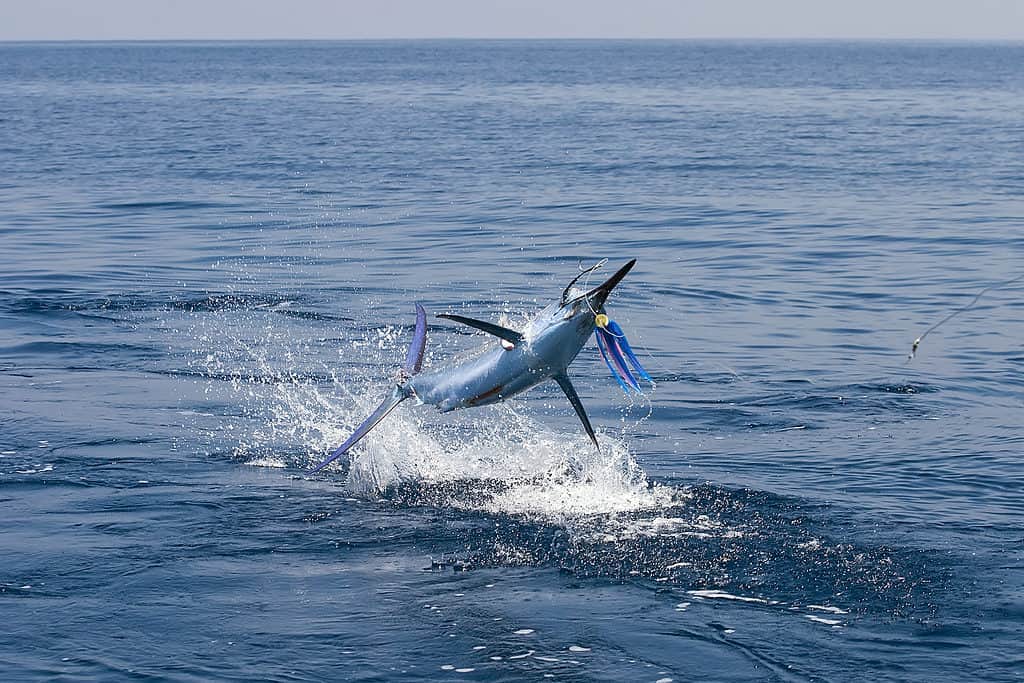
The fastest fish that starts with W is the white marlin, which can reach speeds of up to 80 mph!
©Neophuket/Shutterstock.com
Holding the title for the speediest fish beginning with the letter W is the white marlin! Not only that, it is one of the fastest fish in the world. This remarkable fish can swim at speeds of up to 80 miles per hour!
This deep-sea dweller roams the western Atlantic, making its journey from Nova Scotia to Argentina. You can also spot them in the Caribbean and the Gulf of Mexico.
Appearance-wise, their upper body sports shades from dark blue to rich brown, transitioning to a gleaming silvery-white underside. Their upper jaw extends, forming a spear-like structure, and their first dorsal fin showcases a striking blue-black hue dotted with little black spots.
Generally, white marlin can grow up to 9 feet and weigh around 165 pounds. They fancy the top layers of the ocean, typically swimming between 40 to 100 feet deep, provided the water temperature stays above 66 degrees Fahrenheit.
During the day, these swift swimmers hunt near the water’s surface. Their menu includes a mix of mackerels, herrings, dolphin fish, flying fish, and even squids and crabs.
Summary of the 70+ Fish That Start With W (Common Names)
| Number | Fish Name | Scientific Name |
| 1 | Walea Pygmy Seahorse | Hippocampus waleananus |
| 2 | White Nose Surgeonfish | Acanthurus japonicus |
| 3 | White Spotted Puffer | Arothron hispidus |
| 4 | Wami Tilapia | Oreochromis urolepis hornorum |
| 5 | Woundfin | Plagopterus argentissimus |
| 6 | Walton’s Mudskipper | Periophthalmus waltoni |
| 7 | Whalefish | Cetomimidae |
| 8 | Wolf Eel | Anarrhichthys ocellatus |
| 9 | Whale Shark | Rhincodon typus |
| 10 | Weever | Trachinidae |
| 11 | White Seabass | Atractoscion nobilis |
| 12 | White Cheek Moray | Echidna rhodochilus |
| 13 | White Marlin | Kajikia albida |
| 14 | Wobbegong | Orectolobus maculatus |
| 15 | Whiptail Banjo Catfish | Platystacus cotylephorus |
| 16 | Whitetail Shiner | Cyprinella galactura |
| 17 | Wolf Fish | Anarhichas lupus |
| 18 | Wheeler’s Shrimp Goby | Amblyeleotris wheeleri |
| 19 | White Top Afra | Cynotilapia afra |
| 20 | White Spot Tetra | Aphyocharax paraguayensis |
| 21 | White Pearl Fish | Nematolebias whitei |
| 22 | Warm Springs Pupfish | Cyprinodon nevadensis pectoralis |
| 23 | Walker’s Toadfish | Batrachoides walkeri |
| 24 | White Tiger Goby | Priolepis nocturna |
| 25 | Western Rainbow | Melanotaenia splendida australis |
| 26 | Walker’s Killifish | Fundulopanchax walkeri |
| 27 | Walleye Pollock | Gadus chalcogrammus |
| 28 | Walleye | Sander vitreus |
| 29 | Weather Loach | Misgurnus anguillicaudatus |
| 30 | Western Mosquitofish | Gambusia affinis |
| 31 | Whitebanded Sharpnose Wrasse | Wetmorella albofasciata |
| 32 | Whiff | Citharichthys |
| 33 | White-Barred Boxfish | Anoplocapros lenticularis |
| 34 | White Skirt Tetra | Gymnocorymbus ternetzi |
| 35 | Wartskin Angler Fish | Antennarius maculatus |
| 36 | Warmouth | Lepomis gulosus |
| 37 | White Cloud Mountain Minnow | Tanichthys albonubes |
| 38 | White Ribbon Eel | Pseudechidna brummeri |
| 39 | Wolf Herring | Chirocentrus dorab |
| 40 | White Croaker | Genyonemus lineatus |
| 41 | West African Bichir | Polypterus retropinnis |
| 42 | Waigieu Sea Perch | Psammoperca waigiensis |
| 43 | Waccamaw Killifish | Fundulus waccamensis |
| 44 | White-Barred Wrasse | Pseudocheilinus ocellatus |
| 45 | Walu | Lepidocybium flavobrunneum |
| 46 | White Shark | Carcharodon carcharias |
| 47 | Wallago Catfish | Wallago attu |
| 48 | Waterlot’s Syndonitis | Synodontis waterloti |
| 49 | White Cheek Goby | Rhinogobius duospilus |
| 50 | White Knifefish | Orthosternarchus tamandua |
| 51 | White Piranha | Serrasalmus rhombeus |
| 52 | Waccamaw Darter | Etheostoma perlongum |
| 53 | White Finned Synodontis | Synodontis caudovittatus |
| 54 | Whitetip Reef Shark | Triaenodon obesus |
| 55 | White Spotted Cichlid | Tropheus duboisi |
| 56 | Wimple Fish | Heniochus acuminatus |
| 57 | Weasel Shark | Hemigaleidae |
| 58 | Wedge-Tailed Triggerfish | Rhinecanthus rectangulus |
| 59 | Wolf Tetra | Hoplias malabaricus |
| 60 | Waccamaw Darter | Etheostoma perlongum |
| 61 | Walking Catfish | Clarias batrachus |
| 62 | Winter Flounder | Pseudopleuronectes americanus |
| 63 | Waterfall Climbing Cave Fish | Cryptotora thamicola |
| 64 | William’s Tonguefish | Symphurus williamsi |
| 65 | Wine Red Betta | Betta coccina |
| 66 | Wrestling Halfbeak | Dermogenys pusilla |
| 67 | Wahoo | Acanthocybium solandri |
| 68 | Warthead Goby | Paragobiodon modestus |
| 69 | West Australian Pygmy Perch | Nannoperca vittata |
| 70 | White Tail Bristletooth Tang | Ctenochaetus flavicauda |
| 71 | White-Finned Synodontis | Synodontis caudovittatus |
| 72 | Wrasse | Labridae |
| 73 | Wels Catfish | Silurus glanis |
| 74 | Wolf Eel | Anarrhichthys ocellatus |
| 75 | Wrymouth | Cryptacanthodes maculatus |
| 76 | Western Mudfish | Amia calva |
| 77 | Waigeo Rainbowfish | Melanotaenia catherinae |
| 78 | White-Finned Syndonitis | Synodontis caudovittatus |
The photo featured at the top of this post is © Jan Finsterbusch/Shutterstock.com
Thank you for reading! Have some feedback for us? Contact the AZ Animals editorial team.






